Do you ever get so mad that you want to just throw your cards across the table? I’ve got just the game for you: Monstrous. You get to play as a wrathful Greek god, throwing your mythical beasts down at those puny mortals below.
At a glance: Monstrous is a card-throwing game for 2 to 5 players, ages 13 and up, and takes about 30 minutes to play. It’s currently on Kickstarter, with a $29 pledge (shipping included!) for a copy of the game. Although the box says it’s for teenagers, I think you could certainly play this with younger kids–particularly if they love Greek mythology (or Percy Jackson). Just keep in mind that it does involve throwing cards!
New to Kickstarter? Check out our crowdfunding primer.
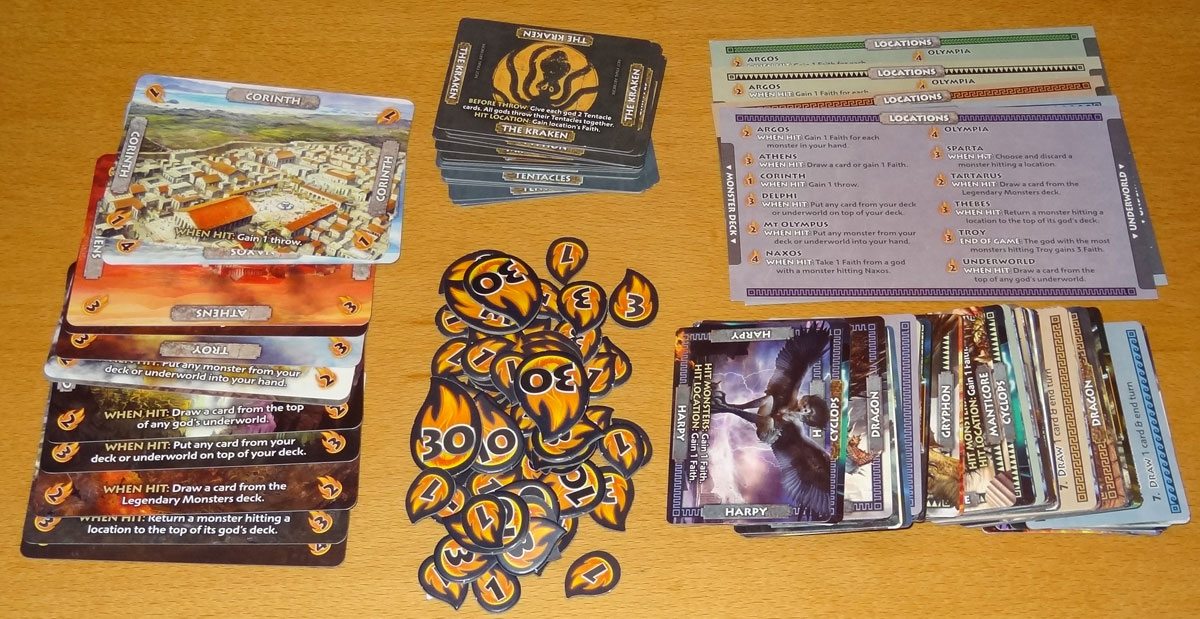
Components
- 60 monster cards (12 each for 5 players)
- 11 extra-large location cards
- 5 rule summary cards
- 5 player mats
- 56 Faith tokens (1, 3, 10, 30 denominations)
The game also includes standard rules and “Lightning Start” rules (though it’s still recommended for at least one person to have read the full rules before playing).

I received an advance production-quality proof of Monstrous to try out, and it’s pretty impressive. The box features some spot UV gloss, and almost all of the artwork for everything is already done. The monsters are nicely illustrated and will be familiar to mythology fans: harpies, manticores, dragons, and so forth.
The Faith tokens are cardboard punch-outs and were pretty nice quality, with different sizes for the different denominations. My only complaint there is that the denominations are kind of weird–we kept trying to make change and would forget that there aren’t any 5s.
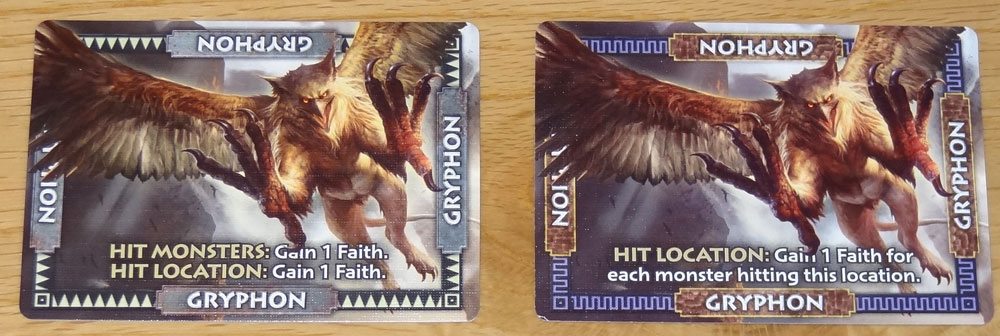
The monster cards are double-sided, with generic abilities on one side (with an “iron” name plate) and monster-specific abilities on the other (with a “bronze” or red name plate, depending on the monster). Each player has the same stack of monsters, differentiated by a narrow decorative border around the edge that matches the player mat and rule summary card. The border is pretty tiny, though–several of my friends didn’t even notice the border until I pointed it out, and when you have piles of overlapping monster cards on the table, it can be difficult to distinguish them at a glance.
The player mats are just large rectangular cards that have the location abilities on one side and the monster abilities on the other, with a small marking on the left and right edge for the player’s monster deck and “underworld” (discard pile). I do wish the rules summary had been incorporated into the player mat because as it is, you have the player mat with rules and a smaller card with other rules at your space at the table. The player mats and rules summary cards are also color-coded and have the same borders as the monster cards, so you can tell who’s who.
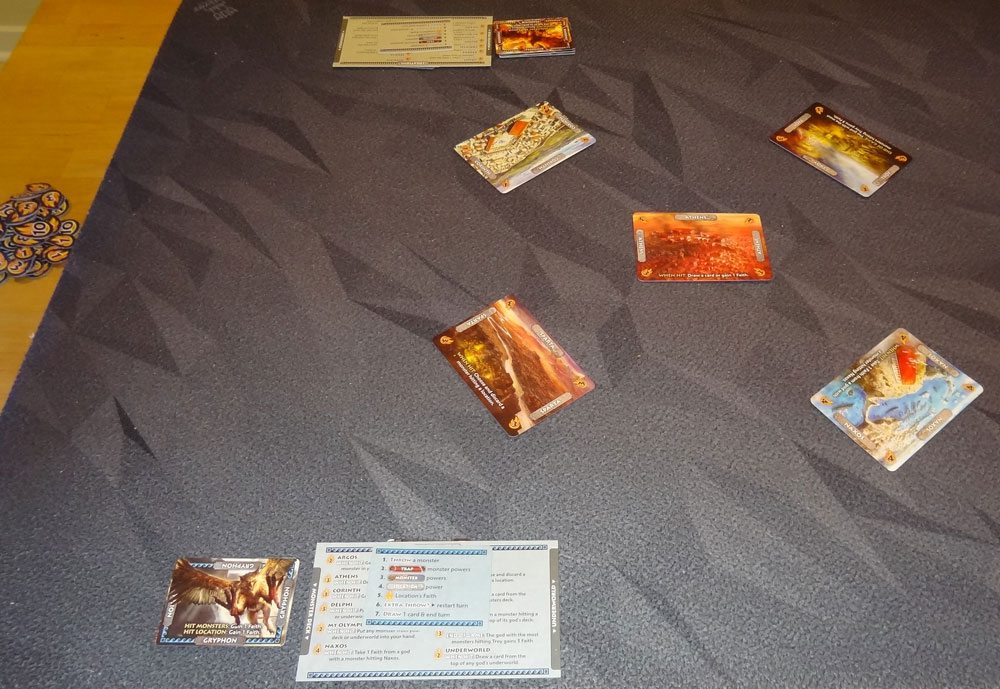
How to play
You can see a current draft of the rules here.
The goal of the game is to score the most Faith points by the end of the game, by taking advantage of monster and location powers.
To set up, you lay out five locations so that they’re too far apart for a monster card to touch more than one location at a time. The rulebook has suggestions for combinations of locations, including one for the first time you play.
Each player gets a player mat and the matching deck of monster cards, and you’ll remove some monsters based on the number of players. (The more players, the fewer cards each player will have.) Each player’s monster deck is shuffled and placed next to the player mat.
On your turn, you do the following:
- Throw a monster
- Activate “Trap” monster powers
- Use your monster power
- Use the location power
- Earn the location’s Faith
If you’ve earned an extra throw, you’ll restart the turn from here. If you have no more throws (or no more cards to throw), then you draw one card and end your turn.
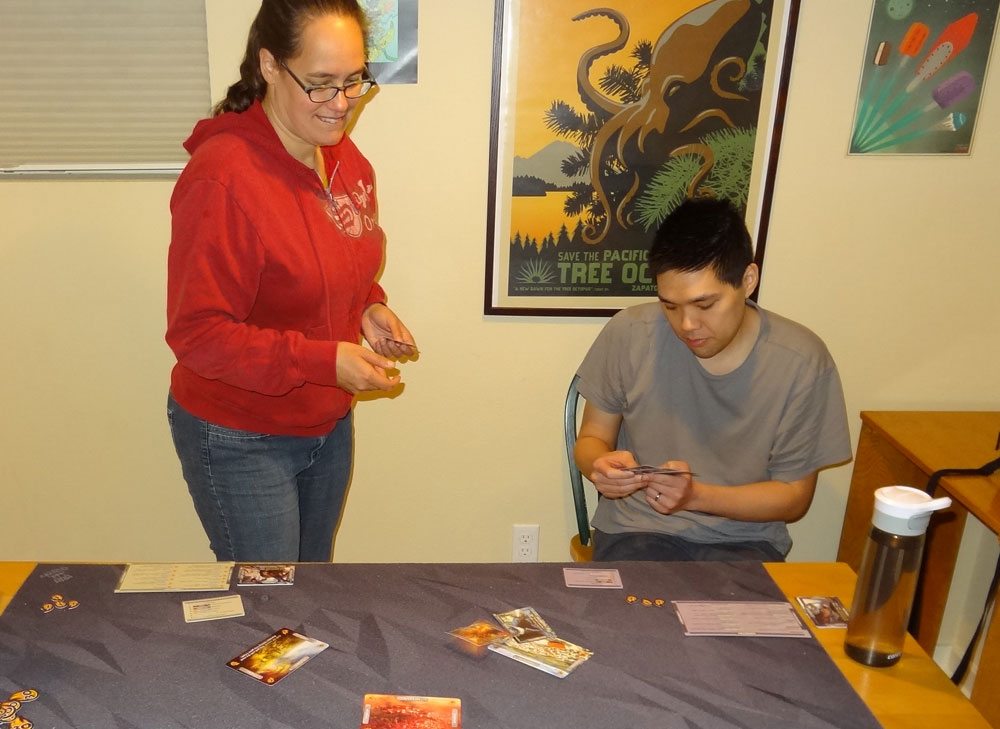
You throw a card, aiming for locations and monsters that are already on the table. It hits if it is visibly overlapping any portion of the card.
Some monsters have “Trap” abilities on the special power side–these are abilities that activate if the monster is hit by anyone after it’s already in play. For instance, the Gorgon will discard any monster that hits it (before that monster’s power activates).
Then, you resolve the powers of the monster you just threw. The generic ability is that you get 1 Faith for hitting a monster, and 1 Faith for hitting a location. If the card lands on the special ability side, then you use that instead. (Sometimes the card will flip over as you throw it, so you may not get the power you were hoping for.)

Next, you resolve the ability of any location that you managed to hit. Location powers vary, from giving you extra throws or card draws to letting you manipulate monsters or gaining Faith. You’ll get Faith points according to the number printed on the location card, if you hit any.
At this point, your turn is normally about over, but if you gained any extra throws (from location abilities or monster abilities) then you get to throw another monster, resolving all the steps again.
Finally, once you’re out of throws (or out of cards), you draw one card and end your turn.
The game ends when somebody has thrown all of their monsters and has none left to draw at the end of their turn. Everyone else subtracts one Faith point for each monster in their deck, hand, and discard pile, and the highest score wins.
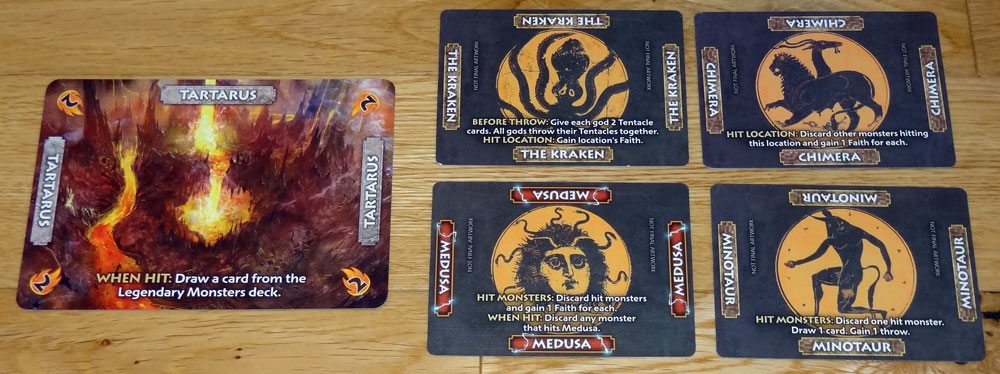
There’s a variant that introduces the Legendary monsters. If you include the Tartarus location, then its power is that you get to draw a card from the Legendary monsters. These have powerful abilities, but you only own the monster for that particular throw. The Kraken is particularly interesting, because before you throw it, every player gets two “Tentacles” cards and everyone throws them simultaneously–they discard any monsters they hit, so it’s a great way to clear out the battlefield.

The Verdict
I like dexterity games, but most of the ones I’ve played involve pieces of some sort (flicking wooden disks, throwing cubes, and so forth). I’ve only seen a few that use cards as the main component, like FlowerFall and Maximum Throwdown. Monstrous has some similarities to Maximum Throwdown (you throw cards rather than dropping them), but the monster and location abilities work differently.
Monstrous provides room for strategic planning–do you want to go for extra cards in your hand, more throws, or points?–but everything still depends on your ability to hit the right target. As with most dexterity games, it’s not just about having a plan, but being able to execute it. For some players, the challenge of tossing a card adds to the fun. But if you’re the sort of person who prefers tactics to physics, you may get frustrated when your careful planning is ruined when your card flips over on its way to the target.
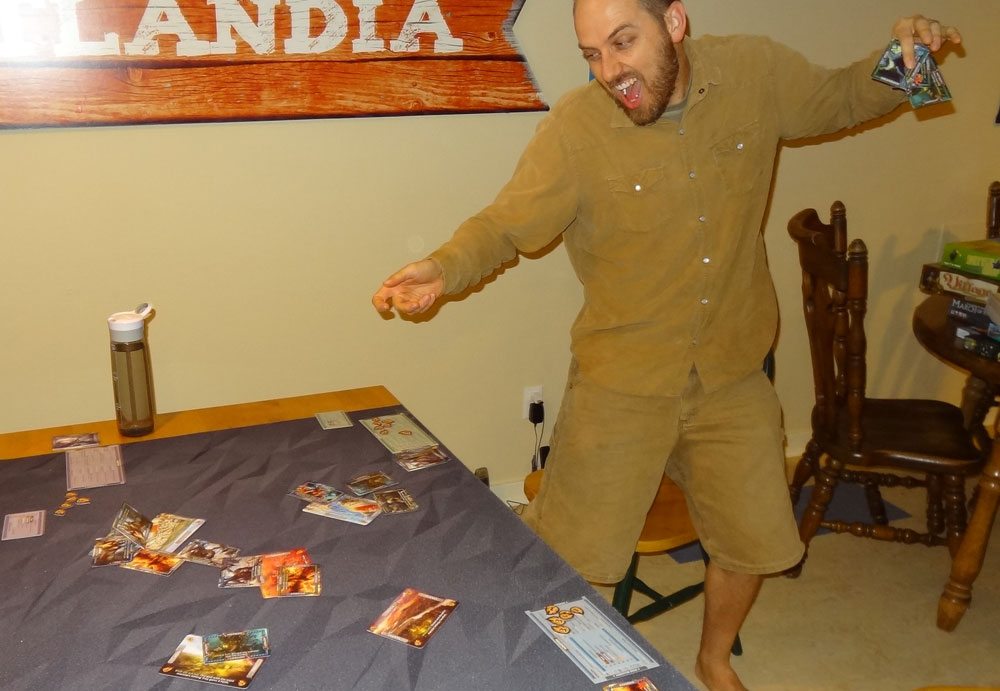
Even so, if you’ve never played a game where you get to throw things, you should give one a try. The atmosphere at the gaming table changes when everyone pushes back their chairs and stands up, and it’s the sort of game that’s raucous fun even if you lose.
I like the thematic ties for some of the special monster abilities: the Gorgon discards any monsters that hit it, petrifying them so they can’t use their powers. The Harpy steals points from other players. The Pegasus gets a second throw if it misses a location. Not all of the powers have a thematic explanation, but there’s a good mix of powers and you can get some fun combinations depending on which monster hits which location.
Overall, it’s a really interesting mix of dexterity and strategy, and it doesn’t hurt that the game already looks so polished. The campaign launched last Tuesday and it is almost funded already. The stretch goals haven’t been announced yet, but keep your (giant Cyclopean) eye out for those.
For more about Monstrous, visit the Kickstarter page.





